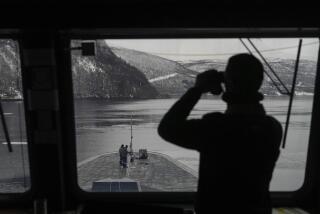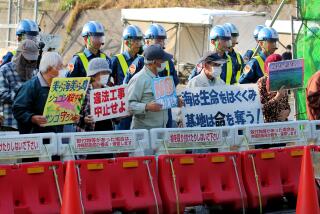Japanese Troops Shore Up Skills
CORONADO, Calif. — On a U.S. Navy base where the streets are named for bloody World War II battles on Pacific islands, American sailors and Marines are now teaching Japanese soldiers the basics of mounting an amphibious assault.
Although the training is said to be somewhat rudimentary, it is meant to boost the capabilities of the Japanese Self-Defense Forces and to further strengthen military ties between the two allies.
“They’re a strong, tough light infantry unit,” Marine Lt. Col. Pete Owen said Thursday of the Japanese soldiers.
“They’re good guys to work with.”
Japanese Col. Yoji Yamanaka, speaking through an interpreter, said the training -- called Exercise Iron Fist -- would help his forces, which are banned by the nation’s constitution from going to war.
The exercise comes at a time of rising tensions between China and Japan. Many Japanese defense planners have urged that the force be modernized beyond its post-World War II defensive role into more of a rapid-reaction force capable of projecting power to confront threats before they reach Japan’s shores.
But Yamanaka disputed the idea that Japan could use the new skills to attack a neighboring nation.
About 150 Japanese soldiers are spending three weeks at the Naval Amphibious Base in Coronado, where the main street is named Guadalcanal.
The training will culminate in a 2 a.m. “assault” on a beach at Camp Pendleton with soldiers rushing ashore as if they are attacking an enemy.
The Japanese soldiers are being trained in driving and navigating small landing craft and swimming through rough surf. An average day begins with a 4,300-yard run and six-mile swim. Officers are being taught how to organize an assault.
The course is a condensed version of the 12-week regimen Marines undergo before they deploy for six months in the Western Pacific.
“We’re just hitting the wave-tops with the skills,” said Marine Gunnery Sgt. Christopher Demuro, one of the instructors.
With 240,000 troops and an annual $50-billion budget, Japan’s Self-Defense Forces are often a cause of domestic political controversy as the Japanese debate their nation’s role in the world and how dependent they should remain on the U.S. for security.
The amphibious assault training has spawned little public alarm.
Prime Minister Junichiro Koizumi’s government has presented Iron Fist to the public as a necessary step in the defense of Japan’s far-flung Ryuku island chain.
The nation’s security establishment has long been worried about what it sees as ambiguity in Washington about whether an attack on islands far from the Japanese mainland would constitute an attack on Japan itself, requiring a U.S. military response.
The importance of defending the Ryukus has increased amid differences with China concerning control over undersea natural gas fields in the East China Sea.
Reports in recent months that the Chinese have conducted exploratory drilling in waters that Japanese maps show as Japanese territory have sparked great unease in Tokyo.
The ongoing political tensions have damped any alarm that an expansion of the Self-Defense Forces’ capabilities might have stirred in Japan.
Japan’s last formal defense policy review, released at the end of 2004, emphasized the importance of Japanese forces being able to conduct operations with the United States.
Yamanaka, the Self-Defense Forces colonel, said he hoped that more Japanese soldiers could come to the U.S. for training.
Marine instructors say Iron Fist will help the Japanese soldiers work as a team, an essential part of any military mission. The training and the final exam at Camp Pendleton are meant to keep them cold, wet and tired.
“When you suffer together, you start to bond together,” Demuro said.
Perry reported from Coronado and Wallace from Tokyo.
More to Read
Sign up for Essential California
The most important California stories and recommendations in your inbox every morning.
You may occasionally receive promotional content from the Los Angeles Times.










